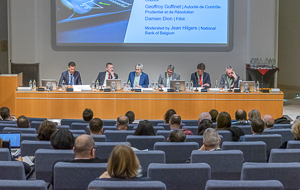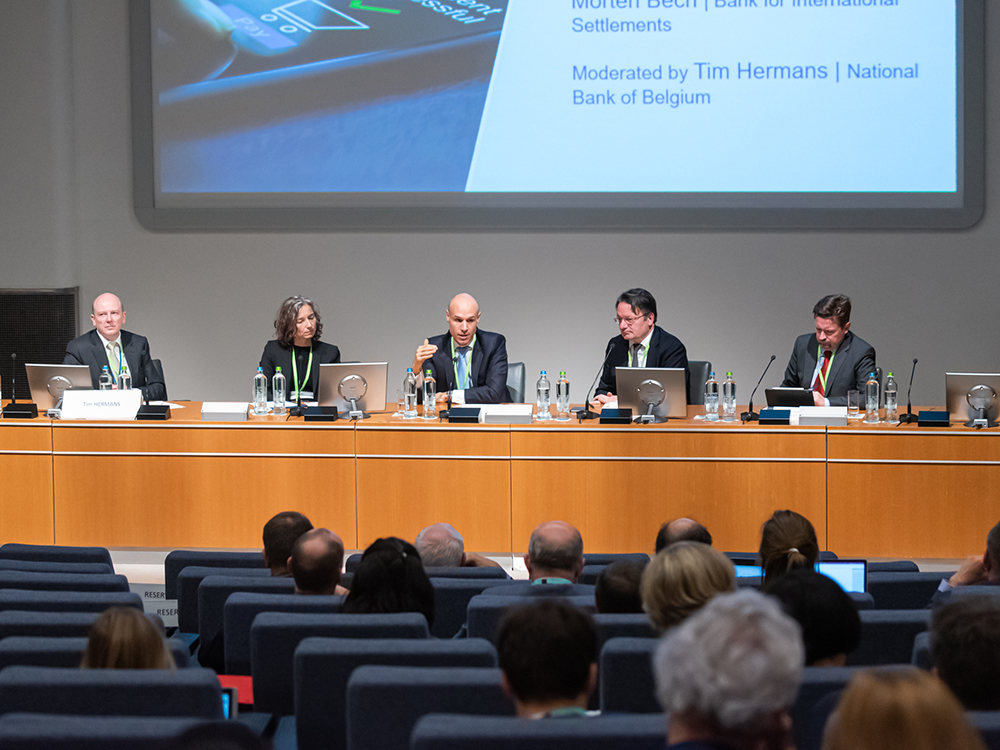Crossing the chasm to the retail payments of tomorrow
January 2020
Technological advancements, evolving consumer demands and intensifying competition are reshaping the retail payment landscape.
In response to growing demand for faster and easier ways of making retail payments, a wider range of payments providers is now offering tangible payment solutions to match user needs.
Traditional banks are competing with new market entrants, such as fintech companies, tech giants and even wearables providers. Technological advancements have opened up a vast new world of possibilities for initiating and processing payments and integrating them more organically in consumers’ lifestyles.
In line with ECB President Christine Lagarde’s recent statement that the ECB “should not only aim to anticipate future trends, but also seek to shape them”, the ECB sees its role in the area of retail payments as that of a catalyst for financial market integration and innovation.
To reinforce its vision of an innovative, integrated and competitive retail payments market across the EU, the ECB joins in initiatives that inspire cross-sector collaboration. Every second year it invites payments executives, policymakers and researchers to a conference on retail payments, focusing on the latest developments and the future strategic direction.
In 2019 the ECB teamed up with the National Bank of Belgium to organise a one-and-a-half-day conference entitled Crossing the chasm to the retail payments of tomorrow which took place in Brussels on 26 and 27 November. Some 40 industry leaders and academics offered valuable insights to more than 200 attendees on topics such as changing consumer behaviour, instant payments, payment initiation services, cyber security and the role of central banks. This article highlights some of the key messages voiced during the conference.
Joint ECB / NBB Retail Payments ConferenceNew payments strategy for Europe
In his introductory speech, ECB Executive Board member Benoît Cœuré, acknowledged that the industry had failed to deliver "payment services that work across borders and that are also faster, cheaper and easier to use". He therefore called for "European stakeholders to step up their collaboration and act together to provide payment solutions that both reflect the demands of consumers and strengthen the Single Market".
With this in mind, Benoît Cœuré announced that the ECB’s Governing Council had recently relaunched its retail payments strategy. The aim is to foster pan-European market initiatives for retail payments at the so-called point of interaction, i.e. the location of purchase. An industry-led solution could be based on the SEPA instant credit transfer (SCT Inst) scheme and existing powerful infrastructures such as TARGET Instant Payment Settlement (TIPS). They should fulfil the following five key objectives:
- pan-European reach and customer experience
- convenience and cost-efficiency
- safety and security
- European identity and governance
- global acceptance in the long-term
Putting customer experience at the centre of payment services

The increasing use of smartphones and mobile apps has changed the way consumers interact in a digital world. They expect payments to advance hand in hand with technology and move seamlessly across borders, platforms and devices. The growing market for payment services allows them to choose from a wider variety of traditional and alternative payment service providers. Thanks to digitalisation, consumers who are dissatisfied with the payment services offered by their current provider can now more cheaply, easily and quickly switch to another.
With consumer experience at the heart of payment services, the conference speakers suggested that finding the right balance between convenience, security and cost is the right way to develop a successful retail payment solution. Moreover, consumers should not be pushed towards certain means of payment or certain technologies, but rather be appropriately informed and allowed to follow their personal preferences.
The trade-off between convenience and privacy
Innovative payment solutions are often tailored to the younger generations. Generation Y, also known as the Millennials, are already in their late 20s and 30s and the early representatives of Generation Z are reaching 20. Both demographic cohorts are confident with technology and more inclined to share their personal or payment data. Some industry leaders mentioned that the qualities of convenience and security should be thought of as complementary rather than opposing.

One of the academic papers presented at the conference sheds light on the attitudes of Dutch consumers towards sharing payments data which would allow for new account information services or payment initiation services. While most consumers are generally unwilling to grant access to their payments data, the willingness increases if (i) their own bank handles the data, (ii) they receive a financial reward, and (iii) they trust the provider.
Are digitalisation and cyber security friends or foes?
Given its dependence on technology and high level of interconnectedness, the global financial system is an attractive target for cyberattacks. One of the panel discussions at the conference focused on whether digitalisation and cyber security were friends or foes, ultimately concluding that their relationship was more complex than that.
Today’s cyber criminals have virtually unlimited access to the latest technologies and resources, whereas a typical financial entity has limited budget and expertise. Moreover, financial entities are hard-pressed to update the new technologies they invest in as often as cyber security would require. This concern is specifically valid for smaller players or new entrants, which generally favour technological innovation at the expense of cyber resilience.
Nevertheless, industry experts see humans rather than technology as the weakest link. Cyber surveys of the financial sector in Denmark recently conducted by Danmarks Nationalbank point to staff training, top management involvement and cyber dependency mapping as the main areas for improvement. These outcomes resemble those of a cyber survey carried out by the ECB across more than 75 financial market infrastructures throughout Europe.
Stablecoins: a bid for convenience on a global scale
Phenomena such as crypto-assets and stablecoins highlight consumer demand for a new and convenient digital payment instrument with global coverage. Projects like Libra are “a wake-up call” and indicate that there clearly is a gap “for cheap, fast and convenient payments”, Valdis Dombrovskis, Vice-President of the European Commission told the conference participants in a video message.
However, volatility and uncertainty are the hallmarks of crypto-assets. This is where stablecoins step in. Though also recorded in digital form, they act more predictably because they use stabilisation mechanisms to minimise price fluctuations. The ECB Occasional Paper In search for stability in crypto-assets: are stablecoins the solution?, which was also presented at the conference, describes the functioning of different types of stablecoins and proposes a taxonomy of stablecoin initiatives. The analysis shows a trade-off between the level of innovation behind the different types of stablecoins and their capacity to provide a stable store of value. The authors also note uncertainties relating to the governance and regulatory treatment of stablecoin initiatives.
How do digital natives want to pay?

The steady increase in cashless payments coupled with the emergence of new payments methods raises questions about the role of cash in a digital society. In the euro area, cash is still the dominant payment method at the point of sale, according to an ECB Occasional Paper on The use of cash by households in the euro area. The situation in Sweden, however, is quite different. Cecilia Skingsley, First Deputy Governor of Sveriges Riksbank presented data showing that the use of cash in Sweden has been steadily declining over the past decade, and fewer and fewer Swedes pay in cash when purchasing goods or services. To address this trend, the Riksbank has started a project to investigate whether Swedish kronor need to be made available in electronic form, as so-called e-krona.
Benoît Cœuré also assured the conference that the ECB will continue to monitor how new technologies change payment behaviour in the euro area. He added that in a scenario of significantly reduced demand for cash“a central bank digital currency could ensure that citizens remain able to use central bank money”. However, he stressed that the ECB and other central banks were cautiously investigating the benefits and costs of such endeavours.


